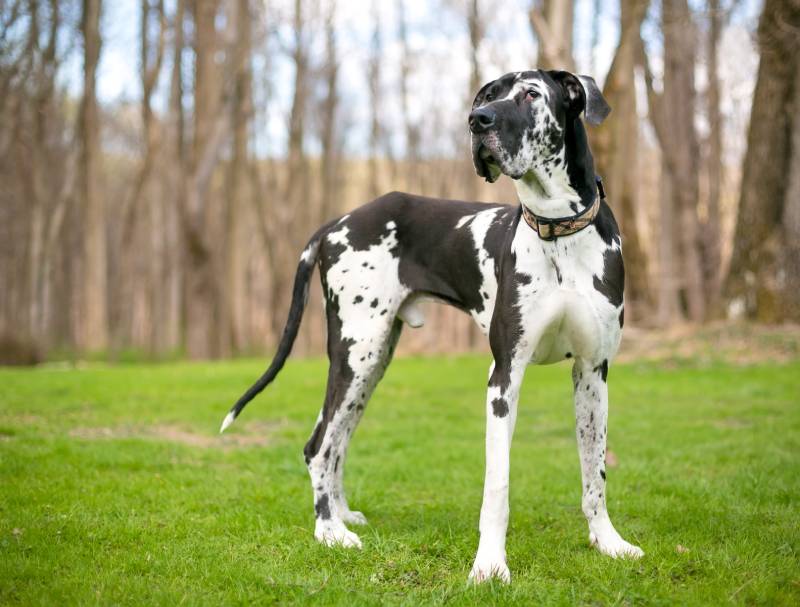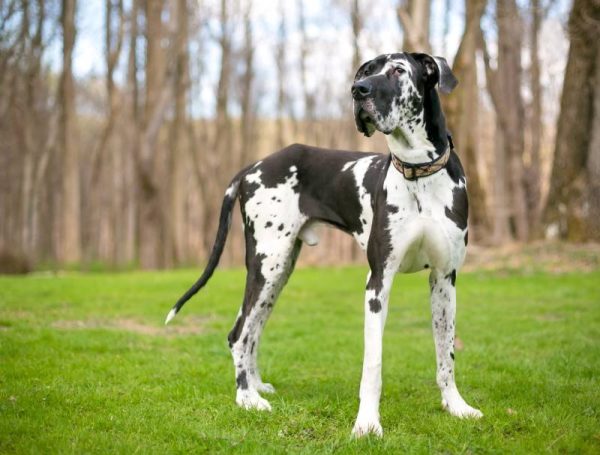Click to Skip Ahead
The Great Dane is easily one of the most recognizable dog breeds in the world. Known for their large size and gentle natures, these dogs make amazing pets for families or anyone else with enough room to accommodate their large size and clumsy antics. One of the most popular Great Dane color variations is Harlequin. The Harlequin Great Dane is a large, gorgeous black and white dog that is striking to see and easy to fall in love with.
Breed Overview
Height:
28–32 inches
Weight:
110–175 pounds
Lifespan:
7–10 years
Colors:
Black and white aka harlequin
Suitable for:
Families, singles with enough space for their size
Temperament:
Loyal & loving, playful, and social
The Harlequin Great Dane features large black spots on a white coat. The uniqueness of this coat makes these dogs highly sought after and breathtaking to encounter. You’ll notice that these dogs can tower over others with their potential to reach 32 inches high. They have smooth coats and a muscularly elegant appearance. Their heads are rectangular and large with a sizable muzzle that’s deep. Of course, like other Danes, the Harlequin has floppy ears. Their eyes can be grey, blue, or green.
Harlequin Great Dane Characteristics
The Earliest Records of Harlequin Great Danes in History
The exact history of the Great Dane, including the Harlequin, is somewhat clouded in mystery. There have been likenesses of these dogs found on Egyptian artifacts that date back to 3,000 B.C. Of course, this could be a similar breed, but the similarities are undeniable. The origins that are documented have these dogs originating in Germany around 400 years ago. It is believed they were bred from Irish Wolfhounds and English Mastiffs to be used for boar hunting.
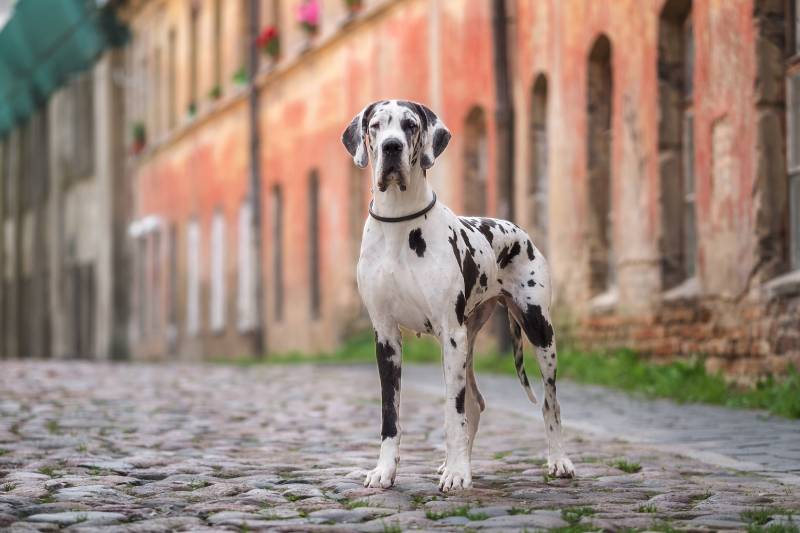
How Harlequin Great Danes Gained Popularity
By the 1600s, German noblemen were taken with these dogs. It was at this time they were brought into homes as pets and protectors instead of only being used as hunters. It wasn’t until 1878 that the idea of naming this large breed came into play. The plan was to distinguish this breed from the English Mastiff. The original name was Deutsche Dogge, which means German Mastiff. After this, German breeders began working on breeding out these dogs’ hunting aggression, making them much gentler. It’s thanks to this work that we have the refined Great Danes we love today. As for the Harlequin coloration, it is difficult to determine when it gained popularity. However, this unique look for these dogs is beloved by many.
Formal Recognition of Harlequin Great Danes
While no one is exactly sure, it is believed that the Great Dane made its way to the United States in the 19th century. In 1887, the Great Dane was formally recognized by the AKC. Harlequin is one of the accepted variations.
Other formal recognitions include the formation of the Great Dane Club of America in 1889, recognition by the United Kennel Club in 1932, and recognition in 1961 by the Federation Cylonogique.
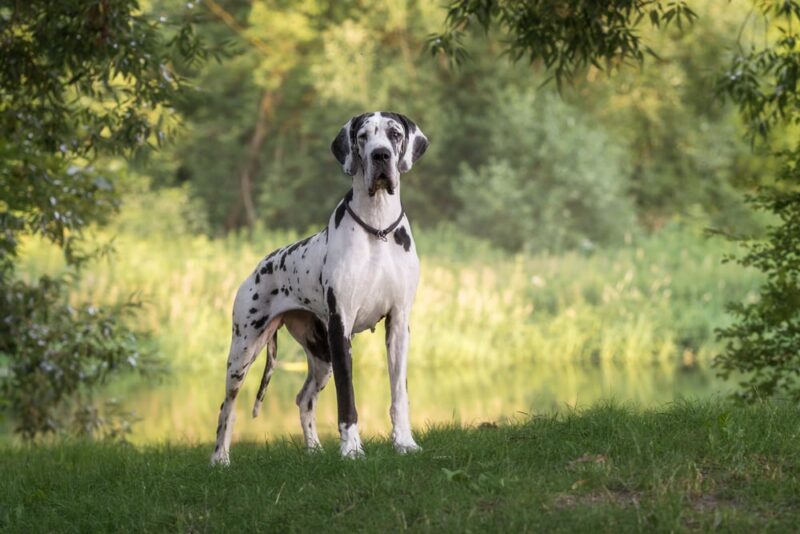
Top 5 Unique Facts About Harlequin Great Danes
1. No Link to Denmark
Despite being named Great Danes, these dogs have no connection to Denmark. As we’ve previously mentioned, this breed originated in Germany and was bred for boar hunting.
2. The Mismarked Danes
While a Harlequin Great Dane features black spots on a white coat, there can be mismarked Harlequins. This happens when the spots are slightly off-color. These colors can be grey, blue, and even fawn. Often these are referred to as brindle harlequins, merlequins, fawn harlequins, and blue harlequins.
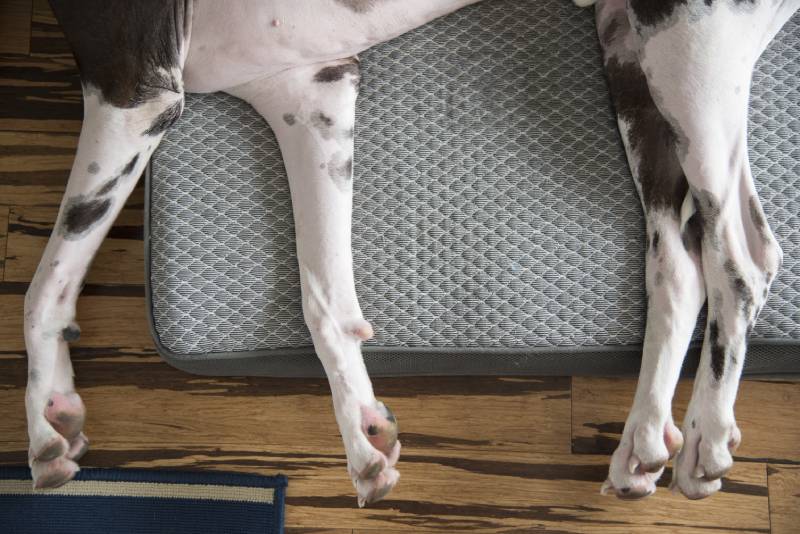
3. Dalmatian Mix-Ups
Yes, Harlequin Great Danes have been misidentified as Dalmatians. This is due to puppies being born with more spots. As a Harlequin Great Dane grows, the spots change a bit and appear more patchy.
4. Harlequin Coats Are Rare
Breeding a Harlequin Great Dane is difficult. To do this, most breeders prefer to breed a Harlequin with a Mantle Great Dane. Mantle Great Danes are white and have what appears to be a black blanket covering their body. Breeding two Harlequins is dangerous. The puppies can be born with a double Harlequin or double Merle gene. This can lead to stillbirths, blindness, and deafness.
5. Slower Growth Spurts
Oddly enough, Harlequin Great Danes have their growth spurt later in life than those with other coat colors. Instead of having their growth spurt at 3 to 5 months old, they usually wait until they are around 11 months.

Does a Harlequin Great Dane Make a Good Pet?
Yes, Harlequin Great Danes make amazing pets. This breed does well with families, including those with small children if socialized early. They are quite gentle and loving to their people. The biggest issue with these gentle giants is their size. If you have small living spaces, Great Danes can easily knock things over or bump into the furniture. You should keep the size of your living space in mind if you plan on bringing a Harlequin Great Dane home.
Another thing to consider if you want a Harlequin Great Dane is the expense. This breed color is quite rare and can cost quite a bit when working with a reputable breeder. You’ll also need lots of food, treats, toys, and of course, a large dog bed for these cuddle bugs.
Conclusion
The Harlequin Great Dane is a color variation of the largest dog breed in the world. These gorgeous dogs are known as gentle giants who love spending time with their families. If you’ve dreamed of having a Harlequin Great Dane, be prepared to pay some money for one.
However, once these dogs are a member of your family, there’s no going back. They will quickly become your best friend and protector of all those in the family.
Featured Image Credit to: Mary Swift, Shutterstock

